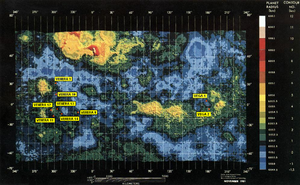برنامج ڤنيرا
(تم التحويل من ڤـِنـِرا)
برنامج فينيرا Venera هو سلسلة من السوابر الفضائيةالروسية أطلقها الإتحاد السوفيتى سابقا لدراسة كوكب الزهرة إما لتدور حول الكوكب أو لتهبط فوق سطحه.
الإطلاق
فى شباط - فبراير 1961م اطلق فينيرا 1 أول سابر فضائي يتجه الى كوكب الزهرة ووصل الى مسافة 62,000 ميل عن الكوكب وفى شباط سنة 1966م وصل فينيرا 2 الى مسافة 15,000 ميل عن الكوكب وفى آذار _ مارس 1966م دخل فينيرا 3 الغلاف الجوي الزهري. ومن السوابر الستة عشر التى اطلقت ذهبت ستة منها ضحية الحرارة والضغط الشديدين قبل أن ينجح فينيرا 9 في إرسال الصور الأولي لسطح الكوكب الى الأرض وقد أرسل فينيرا 13 الصورة الملونة الأولى . وهناك معلومات جمة عن كوكب الزهرة قدمها عدد آخر من سوابر فينيرا الاخرى.
بيانات جميع بعثات فينيرا
| Name | Mission | Launch | Results | Orbiter or probe (flyby, atmospheric) | Lander |
|---|---|---|---|---|---|
| 1VA (proto-Venera) | Flyby | February 4, 1961 | Failed to leave earth orbit | n/a | |
| Venera 1 | Flyby | February 12, 1961 | Communications lost en route to Venus | n/a | |
| Sputnik 19 | Atmospheric Probe | August 25, 1962 | Escape stage failed; Re-entered three days later |  |
n/a |
| Sputnik 20 | Atmospheric Probe | September 1, 1962 | Escape stage failed; Re-entered five days later |  |
n/a |
| Sputnik 21 | Flyby | September 12, 1962 | Third stage exploded; Spacecraft destroyed |  |
n/a |
| Venera 1964A | Flyby | February 19, 1964 | Did not reach parking orbit | n/a | |
| Cosmos 27 | Flyby | March 27, 1964 | Escape stage failed | n/a | |
| Venera 2 | Flyby | November 12, 1965 | Communications lost just before arrival | n/a | |
| Venera 3 | Atmospheric Probe | November 16, 1965 | Communications lost just before atmospheric entry. This was the first manmade object to land on another planet on March 1966 (crash). Probable landing region: -20º to 20º N, 60º to 80º E. | n/a | |
| Cosmos 96 | Atmospheric Probe | November 23, 1965 | Failed to leave Earth orbit, and reentered the atmosphere. Believed by some researchers to have crashed near Kecksburg, Pennsylvania on December 9, 1965, an event which became known as the "Kecksburg Incident" among UFO researchers. All Soviet spacecraft that never left Earth orbit were customarily renamed "Kosmos" regardless of the craft's intended mission. | n/a | |
| Venera 1965A | Flyby | November 26, 1965 | Launcher failed | n/a | |
| Venera 4 | Atmospheric Probe | June 12, 1967 | Arrived October 18, 1967 and was the first probe to enter another planet's atmosphere and return data. Although it did not transmit from the surface, this was the first interplanetary broadcast of any probe. Landed somewhere near latitude 19° N, longitude 38° E. | n/a | n/a |
| Cosmos 167 | Atmospheric Probe | June 17, 1967 | Escape stage failed; Re-entered eight days later | n/a | |
| Venera 5 | Atmospheric Probe | January 5, 1969 | Arrived May 16, 1969 and successfully returned atmospheric data before being crushed by pressure within 26 كيلومتر (16 mi) of the surface. Landed at 3° S, 18° E. | n/a | |
| Venera 6 | Atmospheric Probe | January 10, 1969 | Arrived May 17, 1969 and successfully returned atmospheric data before being crushed by pressure within 11 كيلومتر (6.8 mi) of the surface. Landed at 5° S, 23° E. | n/a | |
| Venera 7 | Lander | August 17, 1970 | Arrived December 15, 1970, was the first successful landing of a spacecraft on another planet and survived for 23 minutes before succumbing to the heat and pressure. This was the first broadcast from another planet's surface. Landed at 5° S, 351° E. | 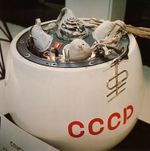
| |
| Cosmos 359 | Lander | August 22, 1970 | Escape stage failed; Ended up in an elliptical Earth orbit | ||
| Venera 8 | Lander | March 27, 1972 | Arrived July 22, 1972 and survived for 50 minutes before succumbing to the heat and pressure. Landed within a 150 كيلومتر (93 mi) radius of 10.70° S, 335.25° E. | 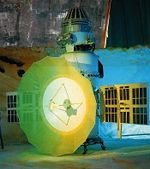 |
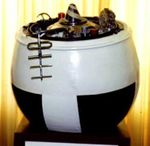
|
| Cosmos 482 | Probe | March 31, 1972 | Escape stage exploded during Trans-Venus injection; Some pieces re-entered and others remained in Earth orbit | n/a | |
| Venera 9 | Orbiter and Lander | June 8, 1975 | Arrived October 22, 1975, sent back the first (black and white) images of Venus' surface while the lander survived 53 minutes before succumbing to the heat and pressure. Landed within a 150 كيلومتر (93 mi) radius of 31.01° N, 291.64° E. | 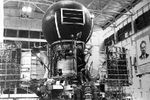 |
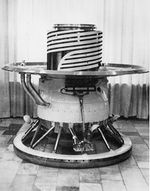
|
| Venera 10 | Orbiter and Lander | June 14, 1975 | Arrived October 25, 1975, the lander surviving 65 minutes before succumbing to the heat and pressure. Landed within a 150 كيلومتر (93 mi) radius of 15.42° N, 291.51° E. | 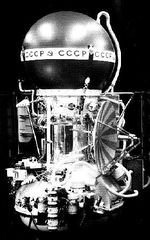 |
|
| Venera 11 | Flyby and Lander | September 9, 1978 | Arrived December 25, 1978, the lander survived for 95 minutes; however the imaging systems had failed. Landed at 14° S 299° E. | 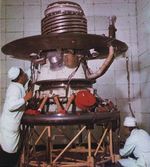
| |
| Venera 12 | Flyby and Lander | September 14, 1978 | Arrived December 21, 1978, the lander surviving for 110 minutes and recorded what is thought to be lightning. Landed at 7° S 294° E. | 
| |
| Venera 13 | Flyby and Lander | October 30, 1981 | Arrived March 1, 1982, returned the first colour images of Venus' surface and discovered leucite basalt in a soil sample using a spectrometer. Landed at 7.5° S, 303° E | 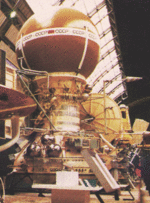 |
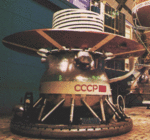
|
| Venera 14 | Flyby and Lander | November 14, 1981 | Arrived March 5, 1982, a soil sample revealed tholeiitic basalt (similar to that found on Earth's mid-ocean ridges). Landed at 13.25° S, 310° E. |  |

|
| Venera 15 | Orbiter | June 2, 1983 | Arrived October 10, 1983 and mapped (along with Venera 16) the northern hemisphere down to 30 degrees from North (resolution 1-2 km) | 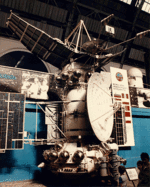 |
n/a |
| Venera 16 | Orbiter | June 7, 1983 | Arrived October 14, 1983 and mapped (along with Venera 15) the northern hemisphere down to 30 degrees from North (resolution 1-2 km) |  |
n/a |
أنظر ايضا
- كوكب الزهرة
- Pioneer Venus
- Vega program
- Vega 1
- Vega 2
- Astron (spacecraft) - a space observatory derived from the Venera bus
- Venera-D - First post-Soviet Venus probe (to be launched in 2016)
المصادر
- مؤمن, عبد الأمير (2006). قاموس دار العلم الفلكي. بيروت، لبنان: دار العلم للملايين.
{{cite book}}: Cite has empty unknown parameter:|طبعة أولى coauthors=(help)
وصلات خارجية
مشاع المعرفة فيه ميديا متعلقة بموضوع :Category:Venus Missions.
الكلمات الدالة:
This article contains content from Wikimedia licensed under CC BY-SA 4.0. Please comply with the license terms.
